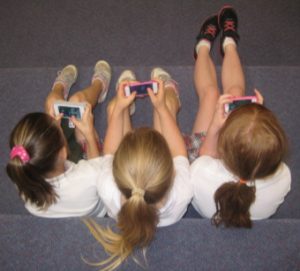Mal Lee
Equity of access to the digital technology is vital for all the nation’s young.
Indeed one could argue it is so from around the age of two or three, the stage when most in digitally connected families begin growing being digital (Chaudron, 2015).
Ideally in a digital world every young person should have their ‘own’ digital device/s and connectivity, free to use largely unfettered. Even the poorest should like every other child be able to stream shows, create, explore, communicate, post, network, and learn collaboratively with the digital 24/7/365, naturally growing in the everyday usage their digital mindset and being digital.
Every child – and not just the advantaged – should enjoy a normal upbringing in a digital and socially networked world.
Without family, and ideally school, access, support and empowerment children will be disadvantaged, educationally, socially and economically.
It is an ideal that has that been pursued, often unwittingly by the digitally connected families of the world for the last couple of decades. Until 2019 they alone had basically provided their children their digital technology and connectivity, and critically shaped its use and provided the requisite support and direction with a digital mindset.
Not government, and only rarely the schools.
The families have done so remarkably successfully, readily evolving their ways in a rapidly changing scene.
Around 70% or near on 4 billion young people are now digitally connected (UNICEF, 2017), (ITU, 2020). That connectivity is not only more than double that in 2010, but is fundamental in that it saw the shift from a dated analogue to a digital medium (ITU, 2011).
Typically 90% plus of children aged three or more have digital connectivity in the developed and increasingly large pockets of the developing world (ITU, 2020). A New Zealand study undertaken post the COVID – 19 shutdown found 93.7% of the students attending Christchurch’s 150 schools had ready home connectivity and access to the desired digital devices (GCSN, 2020), with but 6.3% of students needing government assistance.
Pre 2020 few governments worldwide shared the ideal of national or universal connectivity.
Some did.
England for example mounted its Home Access Scheme (Tolley, 2010), the government of the day believing it imperative all the nation’s young had home connectivity. Sadly most efforts died with changes in government, leaving the families to fund the connectivity.
Most schools and governments was thus unprepared when the 2020 pandemic hit, and were obliged to operate digitally and work collaboratively online with their families. They had not shared the ideals of the families or the young about connectivity. Their thinking was still in large shaped by the traditional, insular, site based mindset which saw no real role for families in schooling, or the need for all the nation’s young to be connected. Most had only a limited understanding of their digital connected families’ digital resources, competencies, and preferred mode of learning with the digital.
One will struggle even today to find a government or education authority which regularly monitors the evolving home digital expertise or resources.
Moreover few had readied themselves to work in a networked mode of teaching, even in a limited form. Revealingly the aforementioned Christchurch study affirmed 22% of secondary teachers markedly underestimated the digital resources of their student’s homes (GCSN, 2020).
Not surprisingly most governments adopted a short term, band aid solution, that paid no regard to the ideals or sterling work of the digitally connected families, or the universal connectivity of the young. Invariably most, in the belief that only they knew best imposed a dated, largely ineffectual, ‘one size fits all’ model of digital use upon the student’s homes. Most opted to hand out laptops – the same model to everyone. A few provided some home connectivity, but the overall message was clear, employ a short term solution until the return to normal schooling.
In fairness most teachers, schools, national and provincial governments, and corporations from the outset of the shutdowns went out of the way to ensure students in need had the gear and connectivity (UNESCO, 2020). You’ll all have heard of the teachers, schools and companies that went to great length to ensure every child was connected, particularly in the rural and regional areas.
Yes sadly in some situations, like parts of the US (Vogels, et.al, 2020) many did not believe it was the role of government to support families in need. In the midst of the first wave of the pandemic only 53% of US adults believed governments should assist home connectivity of the students (Vogels, et.al, 2020).
Most teachers, schools and governments, national and provincial understood the importance of looking after each child, and the political and electoral imperative of being seen to provide the kit and connectivity.
The problem was not the effort expended, but rather the thinking that shaped it, and the failure to adopt a solution for today’s and likely tomorrow’s world.
Collaboration is the key within a networked society. Not unilateral, top down bureaucratic action.
The digitally connected families revealed during the pandemic their ability to operate digitally, demonstrating a level of digital resourcing that has for many years surpassed that available in most classrooms (Lee and Ryall, 2010).
Vitally they also demonstrated their willingness to collaborate with, and support the schools, making possible the remote teaching. They, not government provided the bulk of the digital infrastructure, technology, connectivity and support for the online teaching – at no cost to the schools or government.
They showed why they had successfully connected 90% plus of the developed nation’s young, and why they – and not government – would lead the way to the near universal 24/7/365 connectivity of the nation’s young.
The visionary schools that shaped their operations with a digital mindset, and which had normalised the use of the digital understood the digital capability of their families, and the imperative of genuinely collaborating with them.
They also had long understood the importance of equity of access, and every student having home connectivity. A decade ago in readying BYOT (Lee and Levins, 2012) school after school used as a case study proclaimed the necessity of looking after every child, and the relative ease of so doing.
Why governments and their administrators have still to embrace that imperative makes one wonder.
While still early days post the COVID – 19 shutdowns it appears most governments intend to return to the traditional ways of teaching and schooling, to continue the focus on the basics and use the digital peripherally in the classroom.
In early 2021 one will struggle globally to find any government that provides home connectivity for students in need, or which expresses the desire for universal home connectivity. Situations like Lafayette County (US) are difficult to find.
Most appear to view the pandemic as an aberration, and are letting slide the educational imperative of ensuring every child, and not just the advantaged, have digital access 24/7/365, from early in life.
The very strong message at this point in history is that if your school believes in digital equity of access it must take the lead in its achievement.
The job is not hard.
But it does require a head committed to the quest, and a school staff willing to respect, trust, empower and genuinely collaborate with their families in the use of their digital resources. It entails acknowledging the students will use their own devices and digital resources.
The number of students today in need of support is likely to be small. The Christchurch numbers are likely to be found in most developed nations. A potential challenge is ensuring all students in large families have ready access.
The cost of apt devices has dropped, and continues to fall. Near all schools can provide the financial support or draw on a range of sources to secure the money.
While most schools can fund the access and connectivity there are invariably local service groups and government agencies able to assist as well.
What is required is that each year the school will, as a normal part of its operations with each new cohort sensitively identify those in need of support, and arrange it is provided.
Approach that support with a digital mindset, understanding each family’s situation and needs, empowering the family to make what it believes the apt decision.
It is time to stop the paternalism – well intentioned and unwitting as it might be.
For too long those in authority, the school, the bureaucracy have decided what the poor need.
Try if possible to give money, particularly for the devices.
Understand how important respect, trust and empowerment is to all digitally connected families, and their children. Connectivity is connectivity, but the message communicated in enabling the family, child/children to choose the desired device and apps is immense.
One of the great failings of England’s Home Access scheme (Tolley, 2010) was middle level bureaucrats deciding what technology was appropriate for those in need. Their actions trumpeted very loudly the poor and marginalised couldn’t be trusted to make the right choice.
Digitally connected families worldwide are invariably technology agnostic, using within their ecosystem a mix of operating systems and technologies.
That said most in the family like to choose their own personal device/s. Some will prefer a tablet, others a desktop or laptop. Some will prefer Android, some Apple and others Windows. Some will after a couple of years change.
It matters not.
Nor does whether the students are using gold plated laptops or reconditioned units. It is the capability of the user that counts.
The bottom line is that every one of your students should have apt 24/7/365 home connectivity, able to take charge of their use of and learning with the digital.
Conclusion
In an ideal world the funding for those in need requiring connectivity for their children should be factored into the social service payments, enabling governments to operate all its agencies on the knowledge of universal digital connectivity, obviating the need to prop up a decaying postal service.
But until that is done it will be up to the school.
- Chaudron, S (2015) Young Children (0-8) and Digital Technology Luxembourg, European Commission JRC and Policy Reports 2015 –http://publications.jrc.ec.europa.eu/repository/handle/JRC93239
- Greater Christchurch Schools Network(GCSN) (2020) Closing the Digital Divide during the COVID-19 Lockdown. Christchurch. GCSN – https://9dce24cd-9dc0-4130-974f-92f95f164beb.usrfiles.com/ugd/9dce24_79332a39f2924734856ffa3b5a3ababf.pdf
- ITU (2011) The World in 2010. The Rise of 3G. ITU. Geneva Accessed 23/7/2020 at – https://www.itu.int/ITU-D/ict/facts/2011/material/ICTFactsFigures2010.pdf
- ITU (2020) Measuring digital development. Facts and Figures 2020. Geneva International Telecommunications Union – https://www.itu.int/en/ITU-D/Statistics/Pages/facts/default.aspx
- Lee, M and Levins, M (2012) Bring Your Own Technology Melbourne ACER Press
- Tolley, R (2010) ‘UK Home Access Plan: A Case Study’ in Lee, M and Finger, G (eds) (2010) Developing a Networked School Community, Melbourne ACER Press
- UNICEF (2017) Children in a Digital World. The State of the World’s Children 2017. UNICEF December 2017 – https://www.unicef.org/publications/files/SOWC_2017_ENG_WEB.pdf
- Vogels, E.A, Perrin, A, Rainie, L and Anderson, M (2020) ‘53% of Americans Say the Internet Has Been Essential’. Pew Internet. April 30. 2020 – https://www.pewresearch.org/internet/2020/04/30/53-of-americans-say-the-internet-has-been-essential-during-the-covid-19-outbreak/









